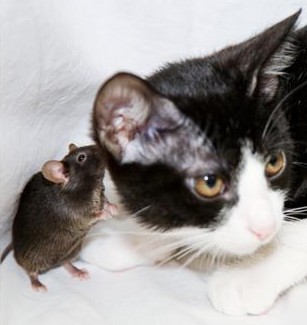Scientists create ‘fearless’ mouse A team of University of Tokyo researchers led by professors Hitoshi Sakano and Ko Kobayakawa have announced they have genetically engineered a mouse that does not fear cats, simply by controlling its sense of smell. By tweaking genes to disable certain functions of the olfactory bulb ??? the area of the brain that receives information about smells directly from olfactory receptors in the nose ??? the researchers were able to create a “fearless” mouse that does not try to flee when it smells cats, foxes and other predators.
In studying the genetically modified mouse, the researchers have concluded that the evasive behavior exhibited by mammals when they smell predators may be genetically hardwired into the olfactory bulb from birth, and not learned through experience as commonly believed. The research suggests that the mechanism by which mammals determine whether or not to fear another animal they smell ??? and whether or not to flee ??? is not a higher-order cerebral function. Instead, that decision is made based on a lower-order function that is hardwired into the neural circuitry of the olfactory bulb. However, in other experiments, the researchers demonstrated that mice with impaired olfactory functions can also be taught to fear their predators.
According to Professor Sakano, the research indicates that behavior in the mammalian brain is determined both by instincts coded into the genes and by “associative circuitry” that allows responses to be learned through the environment.
The results of the research, which are to be published in the November 8 online edition of the British science journal Nature, are expected to help scientists better understand the structure of the brain’s neural circuitry responsible for processing information about the outside world.
URL: http://www.pinktentacle.com/2007/11/scientists-create-fearless-mouse/
Source: http://www.iza.ne.jp/news/newsarticle/natnews/topics/98799/
